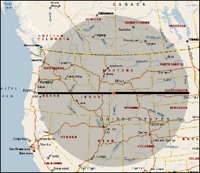 I recently watched the Discovery Channel’s [Supervolcano](http://dsc.discovery.com/convergence/supervolcano/supervolcano.html), a docu-drama about what would happen if the massive [caldera underneath Yellowstone National Park](http://en.wikipedia.org/wiki/Yellowstone_Caldera) were to erupt.
I recently watched the Discovery Channel’s [Supervolcano](http://dsc.discovery.com/convergence/supervolcano/supervolcano.html), a docu-drama about what would happen if the massive [caldera underneath Yellowstone National Park](http://en.wikipedia.org/wiki/Yellowstone_Caldera) were to erupt.
The program had been sitting on my TiVo for a while, because it’s hard for me to commit to an hour of [Alias](http://abc.go.com/primetime/alias/), much less a three-hour made-for-cable movie. But I knew I’d eventually watch it, because from the moment I first heard about the Yellowstone supervolcano, it was one of those nagging, back-of-my-mind fears. So much so, that I actually included a lengthy monologue about it for a script I was writing. (That scene got cut, so feel free to write your own.)
For those who don’t know, Yellowstone National Park, home of the Old Faithful geyser, is actually the caldera of a massive volcano. And not just a “theoretical” volcano: it’s erupted at least three times before: 2.1 million years ago, 1.3 million years ago and 640,000 years ago. Which, if you do the quick math, suggests that it erupts every 800,000 to 660,000 years. Which means it’s due to erupt now.

Which is very, very bad.
When Yellowstone erupts, it will be big-summer-disaster-movie apocalyptic. Think Armageddon x The Day After Tomorrow. Twenty feet of jagged volcanic ash strewn across the Midwest, tapering down to a centimeter on the East Coast. Global temperatures will fall. The monsoon will fail. Drought, famine, starvation lasting for years. As Discovery says on the website:
A modern full-force Yellowstone eruption could kill millions, directly and indirectly, and would make every volcano in recorded human history look minor by comparison.
Suddenly, moving to Australia looks a lot more enticing. Yes, there’s the global famine, but at least you don’t have ash falling on your head.
But here’s the thing: Yellowstone is not actually “due” to erupt. That’s a logical fallacy. And the celebrity spokesperson who proved it to me is [Michelle Pfeiffer](http://imdb.com/name/nm0000201/maindetails).
Let me provide context.
 In 1994, my friend Elizabeth and I went to see [The Madness of King George](http://imdb.com/title/tt0110428/combined) at a movie theatre on the [Third Street Promenade](http://www.downtownsm.com/bwhats_happening.shtml) in Santa Monica. The movie theatre was pretty full, so we ended up sitting next to a man and woman — who turned out to be Michelle Pfeiffer and her husband [David E. Kelly](http://imdb.com/name/nm0005082/). Being good Los Angelenos, we pretended we didn’t know they were beautiful and famous. We just ate our popcorn, watched the movie, and gossiped after they left.
In 1994, my friend Elizabeth and I went to see [The Madness of King George](http://imdb.com/title/tt0110428/combined) at a movie theatre on the [Third Street Promenade](http://www.downtownsm.com/bwhats_happening.shtml) in Santa Monica. The movie theatre was pretty full, so we ended up sitting next to a man and woman — who turned out to be Michelle Pfeiffer and her husband [David E. Kelly](http://imdb.com/name/nm0005082/). Being good Los Angelenos, we pretended we didn’t know they were beautiful and famous. We just ate our popcorn, watched the movie, and gossiped after they left.
The following Saturday, Elizabeth and I went to a different movie theatre and ended up sitting directly behind the Pfeiffer-Kellys. Now, at this point, one could argue we were stalking them. But it wasn’t intentional. It was just a coincidence that we all had the same taste in movies. Still, I felt guilty on some level. I considered saying something, but every scenario I played out in my head ended up with Michelle Pfeiffer looking disgusted, and David E. Kelly getting pushy. And he’s taller than me. So instead, Elizabeth and I just ate our popcorn, watched the movie, and gossiped after they left.
Then a week or two later, Michelle Pfeiffer drove past me on Montana Blvd. We didn’t have a big emotional moment, or bond over a shared reaction to a film, but it happened. Another Michelle Pfeiffer sighting.
I had seen her three times in the course of a month. When I’d tell friends about it, they’d rightly acknowledge it was quite a coincidence. But that’s all it was — a coincidence. Had I seriously said to my friends…
“I’m due to see Michelle Pfeiffer in the next week to ten days,”
…they would have slowly backed away. The fallacy is obvious: three sightings isn’t a pattern, and the two intervals between those sightings is even less of one. The most precise guesstimate a reasonable person could make is that I would see Michelle Pfeiffer again sometime between Eventually and Never. (It turned out to be Never.)
Michelle Pfeiffer is the supervolcano.
All of this is a very name-dropping way of explaining why I shouldn’t lose any sleep over Yellowstone erupting. You can’t say something is “due” just because a similar interval of time elapsed in the past.
That’s really obvious when the subject is a beautiful actress, but harder to grasp when you’re dealing with cataclysmic events. I think one difference is scale: When you’re dealing with millions of years, your brain gets overloaded. You lose touch with common sense, and start thinking purely by numbers. But the more important factor is stakes. If you never bump into Michelle Pfeiffer again, your life won’t be significantly worse. However, if the Yellowstone supervolcano erupts, you die. Or at least suffer horribly.
All of this is not to say we should ignore Yellowstone. Scientists might one day tell us that the area is due to erupt based on studies of magma, crust density, earthquake activity and their correlation with historical patterns. But they’d be looking at the real causes, not guessing based on a two-sentence summary of the situation.
Which leads to the final mystery: Why did I see Michelle Pfeiffer three times in a month, but never since? Well, she used to [live in Brentwood](http://mpfeiffer1.tripod.com/97mirabella.htm), near those movie theatres. But in 2004, she and her husband [moved to Northern California](http://mpfeiffer1.tripod.com/97mirabella.htm).
For the record, closer to the Yellowstone supervolcano.